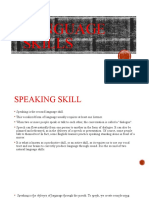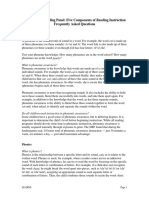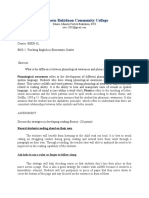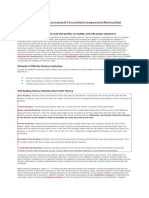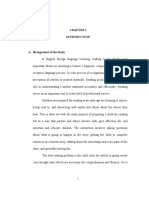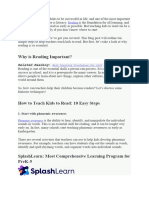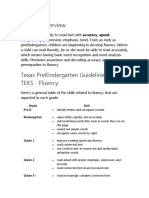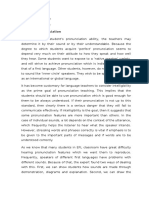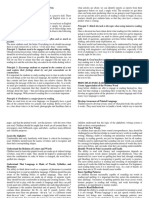3350 Final 2
3350 Final 2
Uploaded by
api-248637452Copyright:
Available Formats
3350 Final 2
3350 Final 2
Uploaded by
api-248637452Original Title
Copyright
Available Formats
Share this document
Did you find this document useful?
Is this content inappropriate?
Copyright:
Available Formats
3350 Final 2
3350 Final 2
Uploaded by
api-248637452Copyright:
Available Formats
Oral Language Oral language is the ability to produce and comprehend a spoken language.
This includes vocabulary and grammar. We use oral language when we listen and when we talk. We teach oral language through experiences that are full of speech, discussion, and conversation. Some specific activities that can help build oral language are: sharing time, nursery rhymes, poetry, singing, and literacy-enriched play. For teaching oral language directly to limited-language students, teachers can use self-talk and think-alouds, paralleltalk, repetitions, and expansions (where the teacher has the student elaborate). Oral language is important to teach because it is our primary way to communicate with one another. If a student does not have any oral language skills, they will not be able to speak or listen to someone else. It is also the foundation for written language. Alphabet Knowledge Alphabet knowledge is one of the foundations for decoding written language. Alphabet knowledge is the name and sound associated with each printed letter. It is also a foundational skill in literacy that links to ease and mastery sound/spelling correspondences, decoding, word reading accuracy and fluency, and comprehension. We teach alphabet knowledge through formal and informal experiences. Alphabet knowledge instruction should begin each day with direct teaching and review of letter names and sounds, followed by activities for students to practice the names and sounds. Some of these activities are: alphabet flashcards (teacher should make sure to mix up the order of the cards), alphabet books, and even students own names. The alphabet song (though it is a popular choice) is not beneficial because students tend to memorize the song rather than associate the letter sound with the printed letter. Alphabet knowledge is important to
teach because children who are confident with letters will be in a better position to focus on words and recognize that words are composed of patterns of letters. Understanding the association between printed letters and their sounds is a critical first step toward the ability to decode words. Print Awareness Print awareness is the knowledge of print conventions. Whenever we reference print, we are using print awareness. Children with print awareness understand that print has different functions depending on the context of where in which it appears. For example, menus list food choices, a book tells a story, a sign can announce a favorite restaurant or warn of danger. Print awareness is also knowing that print is organized in a certain way. An example of this is that we read from top to bottom and left to right. We teach print awareness through explicit instruction where we model the different concepts of print. For example, a teacher could say, students we read from left to right and top to bottom. The teacher could have a few sentences on the board, and a copy for each student, and then tell the students to watch as he/she reads. The teacher would then read the sentences from top to bottom and left to right, pointing at each word as he/she goes along. The teacher would then have the students follow with him/her as she/he reads the sentences a second time. Phonemic Awareness Phonemic awareness comes under the umbrella term phonological awareness or the understanding that streams of speech can be segmented into individual words. Phonemic awareness is the ability to detect, identify, and manipulate phonemes in spoken words. Phonemes are the smallest unit of sound. For example, the word tan has three
phonemes /t/a/n/. Separating a word into its phonemes is called segmenting and when we put the sounds together this is called blending. Segmenting and blending are the two most important aspects used in phonemic awareness. Although letters are often associated with sounds, combining letters with sounds is not phonemic awareness. Phonemic awareness is important to teach because students understanding of blending phonemes together to form spoken words will help them to later understand that printed letters can be blended together in reading printed words-phonics. When teaching phonemic awareness keep it simple and explicit. Teachers can use activities where students are rhyming, blending, or segmenting to help students reach a deeper understanding. Phonics Phonics is where students understand the relationship between phonemes (spoken language) and graphemes (which are used in written language) and then uses this relationship to understand how to spell and read. It is a strategy taught to students to help them decode words they do not know rather then skipping over the words. Phonics is also where students connect phonemes to letters and then applies that to text. When teaching phonics it is important that the instruction is explicit. A phonics lesson should always include: a phonemic awareness warm-up, introduction to sound spelling, blending words, sight words, the use of decodable text, and word work. If teachers are not having students apply what they are learning to actual text it will not be beneficial to the students. Teachers should also remember that when teaching phonics they must stay pure to phonemic awareness.
Fluency Fluency is where word recognition connects to comprehension. In order for students to understand what they read, children must be able to read fluently. Students who do not read fluently sound awkward and choppy. When reading aloud, fluent readers read in sentences/phrases and add expression appropriately. Their reading also sounds smooth and full of intonation. For fluency to be achieved accurate reading is needed. Fluent reading frees up a readers mind so that the reader can focus on the meaning of the text. Fluency must be taught through explicit instruction and teacher modeling. When teaching fluency it is important to focus on one element instead of teaching fluency as a whole. If a teacher decides to teach rate he/she should not instruct students to read faster but instead to read the best that they can. When choosing text to use for practice, narratives are usually preferable. Fluency is an important concept to be taught because it will help readers comprehend what they are reading which will often motivate students to read more often. Vocabulary Vocabulary is all the words within a language that are familiar to a person. Vocabulary begins with oral language or the exposure to an unfamiliar word. Teaching vocabulary is more than teaching word meaning. It involves specific word instruction, word learning strategies, and word consciousness. Vocabulary is important because readers can connect the word to its meaning (that has developed through their exposure to that word). When teaching a vocabulary lesson the teacher should say the word, state the definition, give examples, and ask for other examples to incorporate the word into background knowledge. Then, have students use the word and provide ways for the
students to have multiple exposures to the word. Teachers should remember to choose words that are directly out of text where the students will read or hear in a read-aloud. Also, make sure that the definitions given match the meanings used in the text. Comprehension Comprehension is the understanding of what is read. To comprehend text, readers must first decode what they read, make connections between what they read and what they know, and then think deeply about what was read. Comprehension combines reading with thinking and reasoning. All other concepts that are taught before this are to help students comprehend what they are reading. It is important to help students learn comprehension strategies because if students do not comprehend what they read, reading becomes useless. There are two factors that impact comprehension: reader based factors (i.e. phonemic awareness, phonics, fluency, etc.) and text based factors (i.e. quality of text, narrative vs. expository, etc.) When teaching a comprehension lesson in younger grades, teachers should use just one strategy to focus on and have a graphic organizer that fits the strategy perfectly. However, multiple strategy instruction is our ultimate goal because that is what adult readers use. When teaching strategies it is imperative for the teacher to think aloud and let the students know what the teacher is thinking as he/she reads. A comprehension lesson should follow this order: activate background knowledge, explain, model, guided practice, feedback, and the application. Comprehension lesson should always lead to writing. A helpful tool that can be used with comprehension is a teacher read aloud. Reading aloud gives teachers a perfect opportunity to teach comprehension because it does the decoding work so all students can participate in meaning making.
You might also like
- 3 Research Proposal - Jimenez, Mary Grace P.Document13 pages3 Research Proposal - Jimenez, Mary Grace P.Mary Grace Jimenez100% (3)
- The Five Essential Components of ReadingDocument21 pagesThe Five Essential Components of Readingapi-325181218No ratings yet
- Teaching PronunciationDocument10 pagesTeaching PronunciationMichael MillsNo ratings yet
- Child Care 2 - Connection Between Reading and WritingDocument12 pagesChild Care 2 - Connection Between Reading and Writingrushie23No ratings yet
- Dragon Hunter S3Document22 pagesDragon Hunter S3S TANCREDNo ratings yet
- Beginners Guide On How Speak English Fluently and ConfidentlyDocument12 pagesBeginners Guide On How Speak English Fluently and ConfidentlyKaruna KaranNo ratings yet
- Englishgrade10tg Unit2 150809130021 Lva1 App6891 - 2 PDFDocument147 pagesEnglishgrade10tg Unit2 150809130021 Lva1 App6891 - 2 PDFAlmyr Caezar Dequina83% (6)
- Model Plan de Lectie EnglezaDocument3 pagesModel Plan de Lectie EnglezaHenrietta WagnerNo ratings yet
- 8 Working Chapter 6 Non-VerbalDocument3 pages8 Working Chapter 6 Non-VerbalStanley L. SwartzNo ratings yet
- English Report G 5Document29 pagesEnglish Report G 5Bainaot Abdul SumaelNo ratings yet
- Eslb2083 - English Phonetics and Phonology - Reflective Essay - MS201012534 - Demmie Dennis ChuanDocument3 pagesEslb2083 - English Phonetics and Phonology - Reflective Essay - MS201012534 - Demmie Dennis ChuanDemayy ChuanNo ratings yet
- Reading and Writing Instruction For Students With DisabilitiesDocument27 pagesReading and Writing Instruction For Students With Disabilitiesrawoh-enemodiaNo ratings yet
- Reading Is Fundamental Tech Project 2Document6 pagesReading Is Fundamental Tech Project 2Babe KinakinNo ratings yet
- Language SkillsDocument39 pagesLanguage SkillssairaNo ratings yet
- Basic Reading SkillsDocument20 pagesBasic Reading SkillsGlimech Serenity100% (1)
- 5 Elements of Reading PDFDocument5 pages5 Elements of Reading PDFfuransujinNo ratings yet
- English 2 Module 11-12Document3 pagesEnglish 2 Module 11-12John Michael Porras HambreNo ratings yet
- Teaching of ReadingDocument19 pagesTeaching of ReadingEllaine GraceNo ratings yet
- Teaching GrammarDocument3 pagesTeaching Grammarnour ElarbyNo ratings yet
- ReadingDocument64 pagesReadingJeanJean A-Libo GantanodanNo ratings yet
- What Is Whole LanguageDocument7 pagesWhat Is Whole Languagejonalyn obinaNo ratings yet
- Literacy ComponentsDocument9 pagesLiteracy ComponentsJamila PandicalNo ratings yet
- FluencyDocument2 pagesFluencyapi-77020443No ratings yet
- 3.8 Approaches To Language TeachingDocument9 pages3.8 Approaches To Language Teachinghamid20pcNo ratings yet
- En Effective Early Reading-19-04-2022-AodaDocument21 pagesEn Effective Early Reading-19-04-2022-Aodaapi-703398478No ratings yet
- Improving Students' Reading Skill Through Communicative Language Teaching Method Chapter IDocument13 pagesImproving Students' Reading Skill Through Communicative Language Teaching Method Chapter IdwiNo ratings yet
- Intrinsic MotivationDocument5 pagesIntrinsic MotivationMary Grace DonatoNo ratings yet
- Teachers Want Their Students To Be Successful in LifeDocument6 pagesTeachers Want Their Students To Be Successful in LifeShobana HariharanNo ratings yet
- UNIT 7aDocument10 pagesUNIT 7anariamNo ratings yet
- Approach To Reading: Awang Syarifuddin Afif, Hamzah ShibliDocument18 pagesApproach To Reading: Awang Syarifuddin Afif, Hamzah ShibliAwei WorkNo ratings yet
- Eight Approaches To Language TeachingDocument8 pagesEight Approaches To Language TeachingMihaela Toma100% (2)
- Big Six in ReadingDocument4 pagesBig Six in ReadingMa.Jennifer Zuilan0% (1)
- 2020.11.02 Synthesis Paper (Alberto Hadad)Document11 pages2020.11.02 Synthesis Paper (Alberto Hadad)Alberto HadadNo ratings yet
- PHONOLOGY: Implications To Teaching of EnglishDocument4 pagesPHONOLOGY: Implications To Teaching of EnglishDonnaNo ratings yet
- Description: Tags: RbreadingDocument26 pagesDescription: Tags: Rbreadinganon-879269No ratings yet
- Fluency Overview: Fluency Is The Ability To Read Text With Accuracy, SpeedDocument12 pagesFluency Overview: Fluency Is The Ability To Read Text With Accuracy, SpeedMartinArciniegaNo ratings yet
- Silva Angraini TEFL How To Teach VocabDocument5 pagesSilva Angraini TEFL How To Teach Vocabsilva.angraini26No ratings yet
- Multisensory Lesson Step 1: Introducing The LetterDocument3 pagesMultisensory Lesson Step 1: Introducing The LettertemiyaNo ratings yet
- Diah Permata Kusuma W. 4C (1802109076)Document3 pagesDiah Permata Kusuma W. 4C (1802109076)DiahNo ratings yet
- 5 Ways To Support Students Who Struggle With Reading ComprehensionDocument4 pages5 Ways To Support Students Who Struggle With Reading ComprehensionJherick TacderasNo ratings yet
- Action Research KiwalanDocument15 pagesAction Research KiwalanArnel TingasNo ratings yet
- Language SkillsDocument7 pagesLanguage SkillsAlgen Jewel BalbinNo ratings yet
- Why Phonemic Awareness Is ImportantDocument2 pagesWhy Phonemic Awareness Is ImportantCHRISTINE NADINE LANCANANNo ratings yet
- Instruction TypesDocument7 pagesInstruction TypesElla DimlaNo ratings yet
- Whole Language ApproachDocument5 pagesWhole Language ApproachNawal DahmaniNo ratings yet
- Summary 13-20Document29 pagesSummary 13-20api-305009900No ratings yet
- Submission Assign (HBEC2603)Document12 pagesSubmission Assign (HBEC2603)Angeline Ling100% (1)
- Group 2 (EL 105 - Written Report) PDFDocument9 pagesGroup 2 (EL 105 - Written Report) PDFGabriel Dela Cruz CastroNo ratings yet
- English - How To Teach Pronunciation WellDocument5 pagesEnglish - How To Teach Pronunciation WellCarlos Javier RivasNo ratings yet
- Met OdeDocument11 pagesMet OdeMihra SrebrenicaNo ratings yet
- Enseñanza Ii Primer ParcialDocument7 pagesEnseñanza Ii Primer ParcialRaquel GonzalezNo ratings yet
- Eng 55-Lesson V-ReadingDocument9 pagesEng 55-Lesson V-ReadingMichelle OsoNo ratings yet
- Principles of Eyl-Question No 1&2Document3 pagesPrinciples of Eyl-Question No 1&2SunRose OfficialNo ratings yet
- Alphabetic PrincipleDocument6 pagesAlphabetic PrincipleJohana Upak KalipaNo ratings yet
- Literacy PamphletDocument3 pagesLiteracy Pamphletapi-351831765No ratings yet
- Tutorial Week 1Document10 pagesTutorial Week 1Why BeNo ratings yet
- Summary TeflDocument4 pagesSummary TeflAlVin AryaGiansNo ratings yet
- Four SkillsDocument2 pagesFour SkillsmusrafkamalNo ratings yet
- English 2 Draft ReportDocument7 pagesEnglish 2 Draft ReportJohn Michael Porras HambreNo ratings yet
- Revision Reading and WritingDocument2 pagesRevision Reading and WritingAisha AzmanNo ratings yet
- Main Principles of Teaching ReadingDocument2 pagesMain Principles of Teaching Readingmicas carilloNo ratings yet
- English D.El - Ed.Document40 pagesEnglish D.El - Ed.alok tiwariNo ratings yet
- Vocabulary Enrichment For EngineersDocument5 pagesVocabulary Enrichment For EngineersRohith Shashank100% (1)
- Teaching Reading: Foundational Principles for the ClassroomFrom EverandTeaching Reading: Foundational Principles for the ClassroomRating: 1 out of 5 stars1/5 (1)
- Focus On Grammar 5 (4th Edition) - Focus On Grammar 5 (4th Edition) 2019-06-13 03.35.22 5d01c47a23589Document487 pagesFocus On Grammar 5 (4th Edition) - Focus On Grammar 5 (4th Edition) 2019-06-13 03.35.22 5d01c47a23589blue wolfNo ratings yet
- Class Observation ReportDocument3 pagesClass Observation Reportapi-119302459100% (2)
- The ShallowsDocument5 pagesThe Shallowslilian_armstrong8401100% (1)
- XXX Middle School High Intermediate Esl Course InformationDocument2 pagesXXX Middle School High Intermediate Esl Course Informationapi-377315518No ratings yet
- Development of Language SkillsDocument13 pagesDevelopment of Language SkillsAlexana Bi VieNo ratings yet
- Module 3 - Article Review - Structured Literacy and Typical Literacy PracticesDocument3 pagesModule 3 - Article Review - Structured Literacy and Typical Literacy Practicesapi-530797247No ratings yet
- 2012-2013 Fourth Grade Curriculum DescriptionDocument1 page2012-2013 Fourth Grade Curriculum DescriptionBenLippenSchoolNo ratings yet
- Eng 3081Document78 pagesEng 3081Jessica AngelinaNo ratings yet
- Colvin wrtg120 SyllabusDocument6 pagesColvin wrtg120 Syllabusapi-293311936No ratings yet
- Phyllis Creme, Mary Lea-Writing at University-Open University Press (2008) PDFDocument234 pagesPhyllis Creme, Mary Lea-Writing at University-Open University Press (2008) PDFJairo AcuñaNo ratings yet
- Ta ZC312Document19 pagesTa ZC312AnandababuNo ratings yet
- Motivation To ReadDocument12 pagesMotivation To ReadHoney LibunaoNo ratings yet
- c9 Phcards ZB 4 Jan2014Document96 pagesc9 Phcards ZB 4 Jan2014bhupendra singh sengarNo ratings yet
- Tnready Blueprint g5 ElaDocument5 pagesTnready Blueprint g5 Elaapi-266656006No ratings yet
- Reading PyramidDocument26 pagesReading PyramidJaylie PeñaNo ratings yet
- Xiaoling Yang 2017Document5 pagesXiaoling Yang 2017Jagadhiswaran PeriasamyNo ratings yet
- Training Design Mmes Mid Year Inset 2014Document28 pagesTraining Design Mmes Mid Year Inset 2014Joselle BiñanNo ratings yet
- English Grade 7 Comptencies MatrixDocument7 pagesEnglish Grade 7 Comptencies MatrixLoUie A. Aqui100% (2)
- Course Outline - Principles of Marketing II PDFDocument5 pagesCourse Outline - Principles of Marketing II PDFSagar KanaparthiNo ratings yet
- English Intermediate Reading Comprehension Test 002 - 1Document4 pagesEnglish Intermediate Reading Comprehension Test 002 - 1Gabriel Vazquez VegaNo ratings yet
- ORAL-READING.-Verification.-for-Eval-2022-23 GRADE 6 ODocument2 pagesORAL-READING.-Verification.-for-Eval-2022-23 GRADE 6 OCandido Miao Jr.No ratings yet
- Dev Read Table Lesson 5 and 6Document4 pagesDev Read Table Lesson 5 and 6Jelo Matt CamoronganNo ratings yet
- Thesis FrontDocument11 pagesThesis FrontMirelle OpizNo ratings yet
- SQ3R SsuDocument19 pagesSQ3R SsuMark Aaron SarnoNo ratings yet
- Gmepa - 7Document26 pagesGmepa - 7MarichelleNo ratings yet
- Ryu 2013 Lang Learn Through Gaming Culture PDFDocument17 pagesRyu 2013 Lang Learn Through Gaming Culture PDFRolf NaidooNo ratings yet













